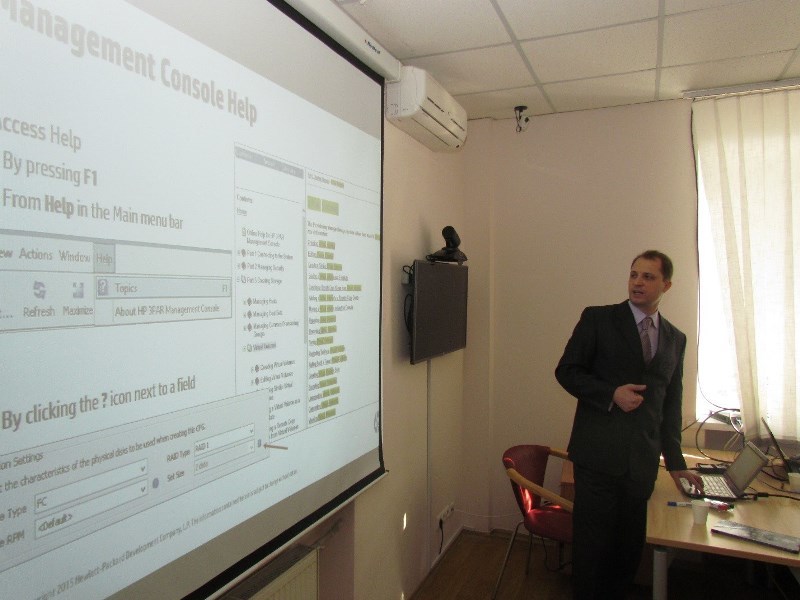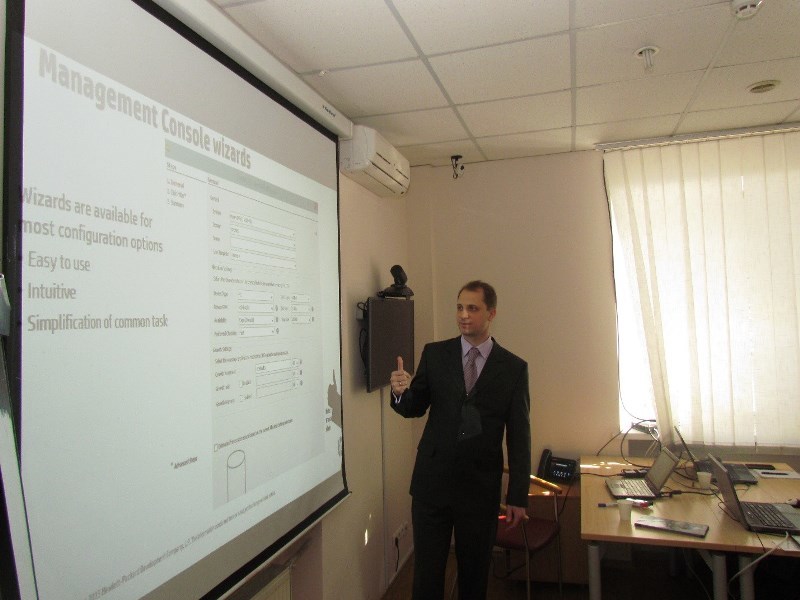Review of Managing HP 3PAR StoreServ technologies in the MUK classroom

Once again, a course on storage management system HP 3PAR based on StoreServ OS (I, II) was successfully held at TC MUK (Kiev ) . This course consists of 5 days, two parts (2 and 3 days), the first part is general information about the 3PAR architecture and its capabilities including local replication. In the second part, we are already talking about remote replication and disaster-resistant configurations. On the first day of the course there was more theory, then all the following days, students were 80% loaded with labs, and only a little theory. Your attention the beginning of the course on storservu. In the first 3 hours, the instructor made a review of the course, which will be the next 5 days, then made a review of the storage system 3PAR , already as part of an in-depth technical course. Under the cut report from the event and record the first 3 hours of the course.
In the course, students got acquainted with all the main teams of 3PAR.

')
To understand how to work with the 3PAR OS, you need to understand the entire topology and architecture of the entire HP 3PAR family. At the beginning of the course, the instructor briefly walked through all the basic, general functionals of 3PAR. (The review of the new 3PAR was already in our blog ). Then, as the new 3PAR appeared, made an overview of what was new. 3PAR is designed in such a way, and this is especially clearly seen in the new, 8 series, which is unique in that it blurs the lines between high-end and mid-range, it can vary from the bottom bar to high solutions. The instructor specifically made a review of the entire architecture, so that students could know exactly “what is working with what and how” at the physical level and at the program level.

Thin provisionig functionality was considered, which, by the way, first appeared in 3PAR. Therefore, its own name migrated to a general term for the entire industry.
A new StoreServ console was considered, which now looks like a unified software for managing all HP equipment - OneView (secretly - very similar to linux). The previous console is implemented in Java, uses port 5753 - encrypted, 5782 - non-encrypted connection - the interface is similar to the thick VMware client. A feature of the console, is that it is one for the entire line of 3PAR. If you own this HP storage management console, you can figure out and manage any 3PAR model, including the high-end for 1 million USD.

The important thing is that the instructor is not a “pure theoretician,” but an engineer who works in projects. Listeners could right here, in our laboratory, "touch" all that was discussed on the course. The instructor brought to disassemble and examine the controller. In this course, the instructor welcomes the deviation in the direction of real problems and questions from the audience.

Basically in the course we are talking about the 7 thousandth series , and also separate modules were added for new models of 8,000 and 20,000 series.
In 3PAR, all disks are virtualized, in order not to load only 1 disk, all data is “smeared”. There is no classic raid, in the traditional sense, a raid occurs not on disk, but by means of blocks. This approach gives independence from iron and fits very well into the modern concept of SSD, where there are no tracks, sectors, and there are blocks. Zero detection is another 3PAR chip, thin provisionig is based on it, 3PAR detects microscopic chunks of 16 kb each, and the nearest competitor has a block (input-output) equal to several megabytes. Another feature is that the entire line of 3PAR storage systems is based on special chips, which hardware accelerates I / O operations, just like a video card accelerates the video of your PC. The main storage vendors were transferred to xeons, but HP remained true to its architecture, which hardware, rather than software, speeds up raids.
"Three guys"
There is a legend about the emergence of a 3PAR storage system among HP engineers; in 2000, they created “three guys”. They acted slyly: they looked at what was in the market for the best and took it into their storage system - and entered the market with it. On this system, "from birth" had to perform many different - heterogeneous tasks. The idea of heterogeneous load in 3PAR solved perfectly. The architecture itself is made so that tasks do not interfere with each other. For example, in 3PAR Virtual Domen ( Virtual Domen ) technology is implemented - when 1 3PAR is divided into several separate volumes, storage systems that do not see each other at all. For example, when a data center is cut between different customers, and they do not interfere with each other, no matter what tasks they put in front of their parts of the storage system.

From the very beginning, 3PAR licensed every sneeze when HP bought 3PAR - the number of licenses decreased significantly. Now, in the case of storage up to 48 disks - you pay for the volume, more than 48 disks - nothing is licensed. Out of the box in 3PAR works without a license - thin provisioning , deduplication , and Adaptive Flash Cash . All other functions are licensed.
Another feature of 3PAR is that this storej loves symmetry and balance. In general, 3PAR is so designed, and there the principle of balance is always observed, if there is an even number of controllers, etc. HP will never sell 3PAR, which is not load balanced. The controller will definitely have a partner, first of all in order to rewrite the cache in case of any failures. Sometimes the requirement of symmetry requires adding more disks and shelves, but productivity increases many times, although, students checked, 3PAR works with any number of disks and shelves, though not always optimally.
Fight controllers
HP 3PAR first began to make 2, 4, 6, controller storage (necessarily a pair number) in the middle-range segment. In 3PAR there is both file and block access. C marking - means unified file and block access, however, this marking was refused in 8,000 and 20,000 series - there all models are already unified from the factory.

ASIC in controller
There was also a module dedicated to the work of 3PAR with cloud technologies and deduplication. For example, in the case when your VMware OS starts formatting a disk, 3PAR will not do anything so as not to load back-end disks, because formatting is essentially writing zeros, and their 3PAR detects in blocks of 16 kb each ASIC, and does not write to the disks, but only updates the metadata, thus increasing the throughput. Also, if you install one Windows OS in VMware, you can deduplicate it to the number of VDI machines you need. Already from the box, without a license, 3PAR is equipped with a port for deduplication. There are vendors that already release disks with an encryption chip, 3PAR does not encrypt these disks independently, it uses chips embedded in the disks, only the key is stored in it. But there is such a rule that if you want to switch to encrypted drives in your 3PAR - you will need to transfer all drives to encryption.
The instructor made a review of different software to assess what you can get with 3PAR, or how else you can use. To consider in more detail what you are and where you will receive in 3PARe - students used the HPE QuickSpecs tool .

Separately, the instructor focused on common issues that engineers and system administrators face when working with 3PAR. About when and how service requests are handled. For which partner numbers the service contracts for 3PAR are tracked. In which case it is not worth the risk to lose service support.
Also, the instructor pointed out "chips", which few people pay attention. For example, the developers were tasked with the convenience of a management console (one that looks like OneView). The developers have done something like an internal Twitter system, where all the records of the system, its status, etc. are recorded. Is a great tool for reviewing the overall picture and storage history for administrators. He told about the web version of the management console (OneView), which can manage up to 16 3PARs. This web platform, which not everyone can, for the time being, but will soon be able to manage any HP hardware, be it a server, storage, or switch. In the administration of 3PAR storage, this web platform is already used when you create file services (this functionality is called File Persona). Another plus of this web console is that there is a search for “everything”. Since if you have 16 3PARs, for example, then finding something without this search is problematic, the search is similar to windows search. An interesting feature for archiving data is Virtual Lock - it happens that customers have requirements when “data has to be stored for 5 years” - and 3PAR can lock data at the hardware level, and even cannot unlock them :).

The instructor, in addition to the points concerning only software, touched upon purely technical points, which are described in few places. For example, he told that in the equipment series different revisions are used (with different xenon). After all, few people know about the firmware, which can reflash the equipment of the 7200 series to 7400: the hardware is the same, and the functionality is activated in the console. Also, 3PAR has such a trick - the power supply unit has its own battery, so that if the power cord is suddenly pulled out, so that it can write off the data from the cache. It was also considered tuning the performance of the system and features of its implementation.
And there are many, many other things that were covered in this course, which we did not write about, you can watch on video, or attend courses on your own.
After the first two parts of the Managing HP 3PAR StoreServ course, you will be able to visit the third, the newest and most advanced part, where there is a deepening in the Adaptive optimization technology and AdaptiveFlashCache .
Below is a video of the first 3 hours of the course.
We invite you to the next 3PAR training courses:
January 18 - 20, 2016 HK902S Managing 3PAR Disk Arrays
January 21 - 22, 2016 HK904S Managing HP 3PAR Disk Arrays: Replication and Performance
February 8 - 10, 2016 H9P97S Managing HP 3PAR StoreServ III
Distribution of HP decisions in Ukraine , Georgia , Tajikistan , CIS countries .
Training courses on HP technologies in Kiev (TC MUK)
MUK-Service - all types of IT repair: warranty, non-warranty repair, sale of spare parts, contract service
Source: https://habr.com/ru/post/272435/
All Articles